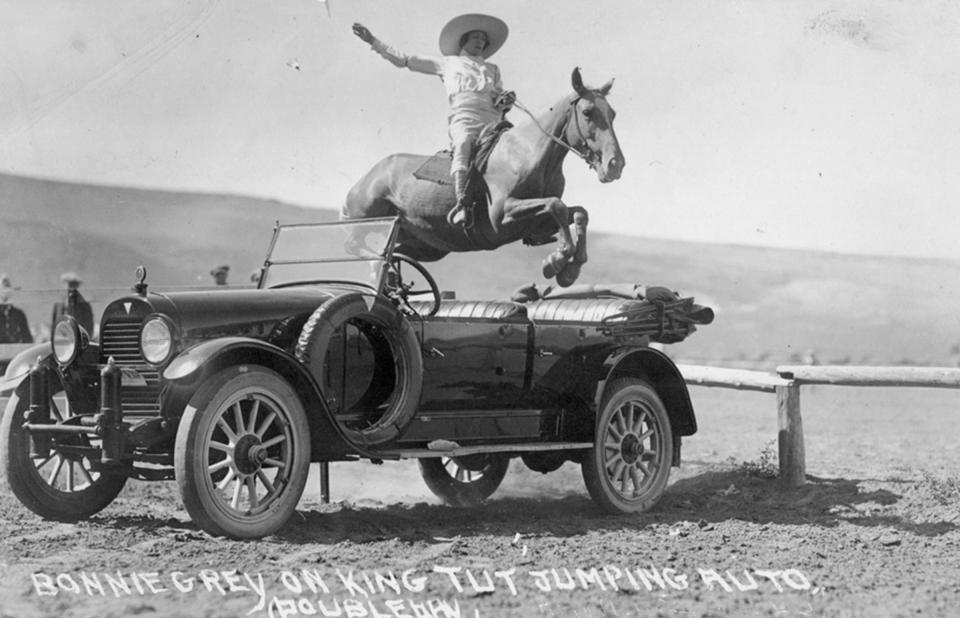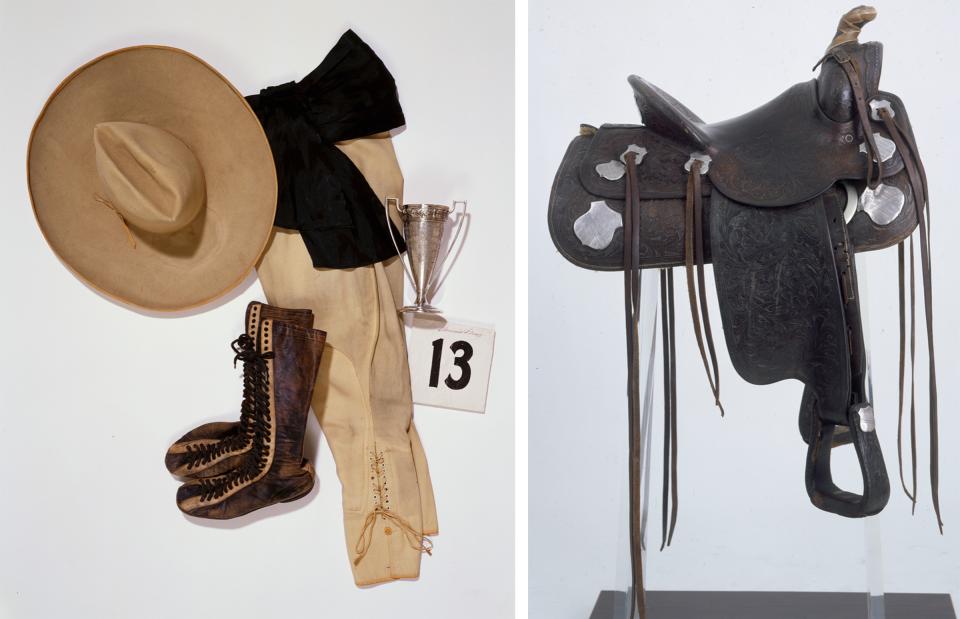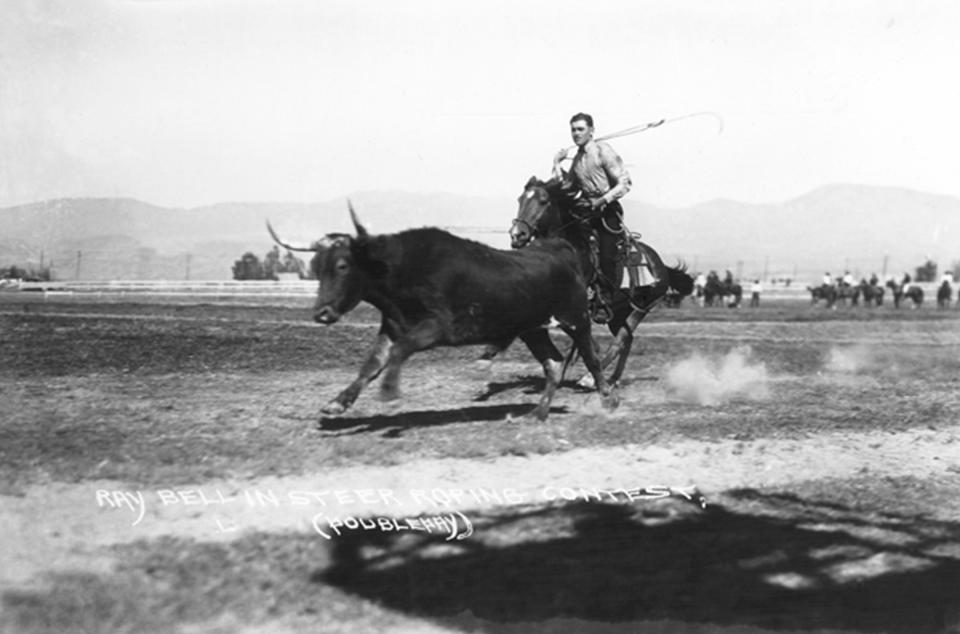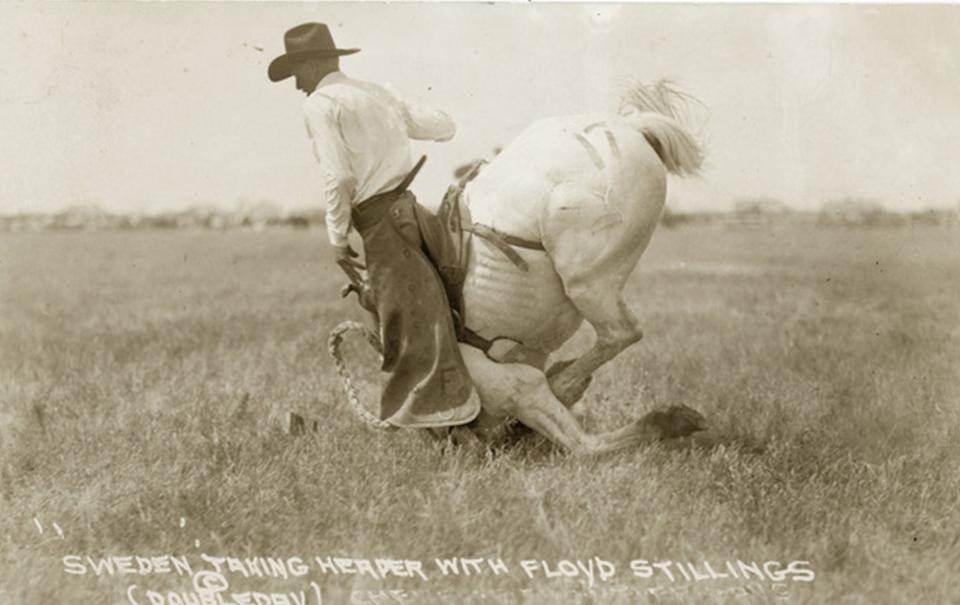Showbiz and Rodeos: Some Wyoming Cowboy Connections in L.A.

By James H. Nottage
Although I was born and raised in Wyoming, my career as a museum curator drew me to jobs in other parts of the country. It has been a source of joy and homesickness to connect with people and events in the history of my native state. Beginning in 1985 my wife Mary Ellen and I were hired to develop what is now the Autry National Center in Los Angeles. Founded by film, record and television star Gene Autry and his wife Jackie, the museum is now a profoundly significant center for the study and preservation of the history of the West.
While Hollywood westerns were populated by many actors who could not ride a horse, skilled riders were the key to training horses and doing the real riding on camera. Legitimate riders who earned their spurs the hard way worked as trainers, extras, stunt performers and in other ways to give an element of realism to Hollywood westerns. Many of these men and women had connections with Wyoming.
R. Kurt Johnson’s recent Wyohistory.org article about postcards and tourism brought back cherished memories of a few riders from the 1920s and 1930s. The first illustration in Johnson’s article is an image of Bonnie Gray [her name is spelled wrong in the handwritten caption on the card] on her famous horse King Tut, performing her daring stunt of jumping the horse over an open car. I knew the image well and, in late 1987, met this 96-year-old lady who contacted the museum to see if we were interested in any of her souvenirs from a remarkable life tied to horses, rodeo, movies, and performing at shows across the country and through many parts of Europe.
Bonnie Gray was born in Washington state, earned a degree in music from the University of Idaho, became a tennis champion and turned her athleticism toward trick horseback riding. She also was the first woman to ride bulls in Mexican rodeos and, in addition to jumping over cars with King Tut, she claimed to be the first woman to perform an under the belly crawl while riding a running horse. After moving to Los Angeles, she performed as a stunt rider for such stars as Tom Mix, Tim McCoy and Hoot Gibson.
At Gray’s Burbank, California, home, museum staff selected her grand cowgirl Stetson hats, sashes, jodhpurs, tall lace-up boots, makeup containers, photographs and many other items. We turned down the coffee table supported by King Tut’s preserved legs! Bonnie Gray passed away shortly after our meeting. Her funeral in April 1988 was a quiet affair compared with the uproar of fans who in the past had greeted her at Cheyenne Frontier Days and other rodeos. Looking through the small crowd, we noted that among those paying tribute at her burial was world champion cowboy Casey Tibbs.
Soon after meeting this fascinating person, I happened to connect with two other champion riders who made their homes in the Los Angeles area. Ray Bell (1899-1996) was born in Iowa, but grew up outside Cheyenne where he rode in area rodeos and fairs. He described himself as a “country cowboy out of Cheyenne,” and following service in World War I began a nearly 40-year career in rodeo. He concentrated on saddle-bronc riding and steer roping, winning titles in the former at rodeos at Pendelton, Boise, Weiser, Idaho and Ritzville, Washington. He also earned three titles in steer roping and Bell’s winning ways also took him to London, England, California and Texas. In 123, he earned the saddle bronc-riding championship at Madison Square Garden, New York.
In the late 1980s Ray Bell was almost completely deaf and it was difficult to communicate with him. He had retired to raise polo ponies and racehorses, but he was still a “country cowboy out of Cheyenne.”
About the same time, another of the great riders with solid ties to Wyoming approached me at the Autry Museum. Well into his eighties, Floyd Stillings (1904-1995) still carried and expressed himself as a tough-as-nails cowboy of the old school. Born in Kansas, he ran away from home to join a wild west show at the age of 13. Stillings rode in rough stock events at rodeos all over the country and in Japan, Australia and England. He said of himself that “I led a wildcat’s life. You had to be about half bronco to do it.” At the height of his career in 1932 he gathered saddle bronc-riding titles in 29 of 36 rodeos and in earlier years won at Chicago, Cheyenne (1929), Pendleton and twice at Madison Square Garden. For those who know the great rodeo broncs it is notable to reference the fact that he rode the famous Five Minutes to Midnight five times. He retired in 1942 to focus on training racehorses. In his last years he still spent time visiting at Santa Anita racetrack and at many rodeos.

Right: Saddle made by Fred Mueller of Denver and won by Floyd Stillings at Cheyenne Frontier Days, 1929. The silver plate is engraved in part: “Presented by Union Pacific Railroad To Floyd Stillings Winner of World’s Champion Bucking Contest.”
Photographs courtesy of the Autry Museum of the American West.
Floyd Stillings wanted to donate his most prized rodeo possessions to the Autry Museum, but asked to present them in person to Gene Autry. The two knew each other well and when Floyd brought his donation to the museum, the two sat and recalled their experiences and other old friends from the 1930s and 1940s. One part of the conversation sticks with me to this day. The two talked about W.T. Johnson, the Texas rodeo promoter who owned rodeos across the country, professionalized the business and promoted the shows far and wide. Autry and Stillings both rode or performed at his rodeos before he sold out his interests in 1937. Gene Autry commented that Johnson “took the dirty shirt off the cowboy.” Both men nodded in acknowledgment of the statement’s truth.
Floyd Stillings presented the museum through Gene Autry his 1929 Cheyenne Frontier Days champion saddle, lace-up boots, spurs, chaps and other prized evidence of his rodeo career. Among the items was the Remington rifle awarded to him by Ranch Romances Magazine at Madison Square Garden in 1933. He told many stories of hunting in Wyoming with this .30-06 rifle and of his earlier home in Cody, Wyoming. He died and was buried there in 1995.
James Nottage is a frequent contributor to WyoHistory.org.
Read Greetings from Wyoming: Postcards and the Tourist Culture
Read Ed Farlow, Tim McCoy and Their Native Friends on Stage and Screen


